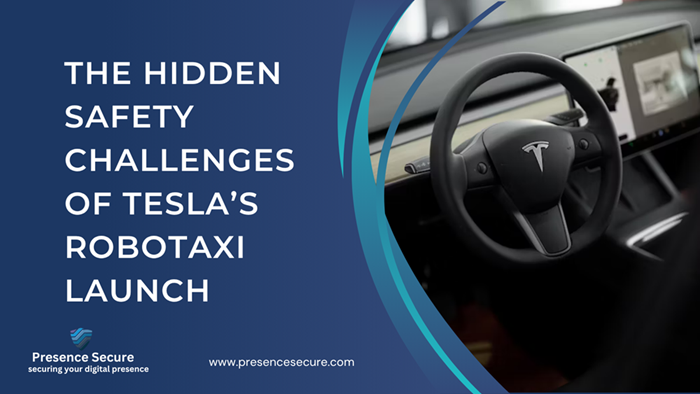Tesla’s Robotaxi launch is redefining how we think about transportation, blending AI, autonomy, and electric mobility into a driverless ride-sharing service. Elon Musk has promised a future where cars drive themselves, cutting down traffic deaths, improving accessibility, and revolutionizing urban transit. But behind the excitement lies a critical conversation we must have: What are the hidden safety risks of handing the wheel over to machines?
As the world inches closer to full autonomy, this article explores the unseen safety challenges Tesla and society must navigate to make Robotaxis truly road-ready.
- Overreliance on AI Decision-Making
Tesla’s self-driving system, powered by neural networks and computer vision, is built to “learn” from billions of miles driven. But despite its impressive capabilities, AI still struggles with edge cases unusual or unpredictable situations such as:
- A child unpredictably running into the road.
- Unmapped construction zones.
- Emergency vehicle interactions.
Unlike human drivers who can use judgment in unfamiliar scenarios, AI operates based on learned patterns and may falter when confronted with novel or ethically ambiguous decisions (e.g., who to protect in an unavoidable crash). Without a human behind the wheel, the backup plan may not be sufficient in such cases.
- Infrastructure Readiness
Tesla’s Robotaxis rely entirely on road markings, signage, and traffic signals. But in many cities:
- Lanes are poorly painted or non-existent.
- Stop signs are faded or missing.
- Road signals malfunction or vary across regions.
These inconsistencies can lead to misinterpretation by AI systems. If a Robotaxi can’t accurately perceive or understand its environment, the result could be catastrophic especially at high speeds or in densely populated areas.
- Hacking and Cybersecurity Risks
Self-driving cars are, in essence, computers on wheels. This means they’re vulnerable to the same types of attacks as any other connected device. A compromised Robotaxi could lead to:
- Hijacking the vehicle remotely.
- Disabling safety features.
- Accessing personal passenger data.
With millions of rides happening daily in the future, Robotaxis could become high-value targets for cybercriminals or even terrorist attacks if not properly secured.
- Passenger Behavior and Vandalism
Without a driver in the car, who enforces rules?
- What happens if a passenger refuses to exit, call the Police?
- How do you stop someone from damaging the vehicle?
- What if passengers threaten or harm other passengers?
Tesla will need to develop advance monitoring systems, in-car state-of-the-art communication tools, and emergency protocols. But even with cameras and sensors, ensuring physical safety inside the vehicle remains a significant challenge.
- Weather and Environmental Conditions
While Tesla’s autonomous driving has improved dramatically, adverse weather still poses a threat:
- Heavy rain, fog, and snow can obstruct sensors.
- Glare or low light can confuse vision-based systems.
- Flash flooding, fallen trees, or debris may not be recognized or navigated safely.
Human drivers use common sense and adaptability in these situations. Autonomous cars must rely solely on programming and limited sensory input potentially creating dangerous blind spots.
- Legal and Liability Uncertainty
If a Robotaxi crashes, who is at fault?
- The car manufacturer?
- The software developer?
- The passenger who requested the ride?
Current traffic laws are written for human drivers, not AI systems. Until lawmakers catch up, Tesla and other automakers are operating in a legal gray zone especially in countries without clear autonomous vehicle regulations.
- Coordination With Human Drivers
Tesla’s Robotaxis will share the roads with traditional vehicles many of them driven by impatient, distracted, or reckless humans. Autonomous cars follow rules strictly. Human drivers often don’t. This mismatch in behavior can lead to:
- Miscommunications at intersections.
- Sudden lane changes that confuse the AI.
- Road rage incidents from humans frustrated by the conservative driving style of a robotaxi.
This dynamic creates friction on the road, potentially leading to avoidable accidents.
Conclusion:
Promise and Caution Must Go Hand-in-Hand
Tesla’s Robotaxi concept holds incredible promise: fewer accidents, reduced or zero emissions, and more accessible transport. But the path to a driverless future is not just technical it’s human, legal, ethical, and infrastructural.
The hidden safety risks of Tesla’s Robotaxi launched aren’t reasons to stop progress, but they are reasons to pause, plan, and prepare. Every stakeholder from engineers to city planners to lawmakers and the public must collaborate to ensure that safety, not just innovation, drives this revolution.
Cybersecurity Mesh Architecture (CSMA) decentralized security framework is enables interoperable security solutions across different environment. However, its centralized policy management creates bottlenecks. Reducing vulnerabilities in complex, multi-cloud setups requires multilayered security laser approach. Because when no one’s holding the wheel, safety has to be in the driver’s seat.

